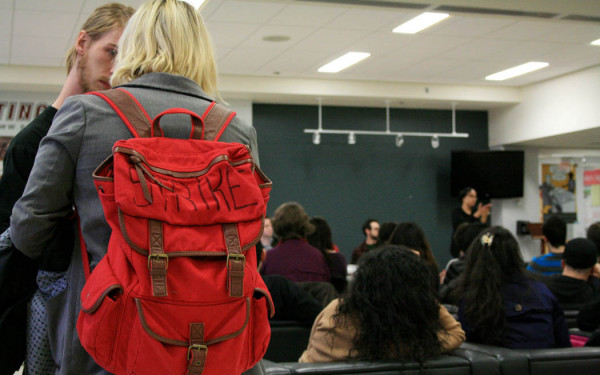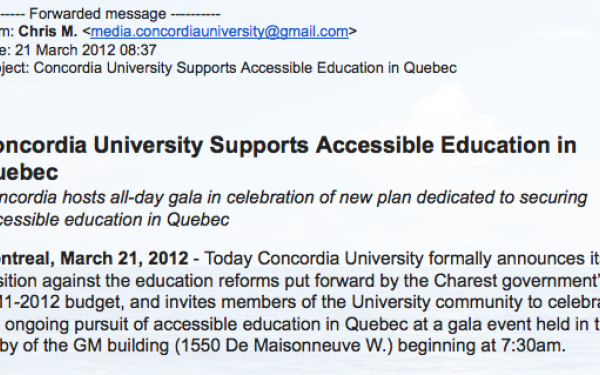Beyond the Picket
How Artists are Tackling the Tuition Issue
Activism can be visualized in bodies dressed in red, rippling waves of movement and free cookies. Because that’s exactly what happened for an hour on the first floor the EV building; a small student performance inclined passers-by to stop and watch and inevitably take part in the strike debate.
Since their vote on March 2, Fine Arts students have been proving that there’s much more to this strike than picket lines. Groups of students have been meeting regularly to coordinate demonstrations, coming together based on their desire to inform their fellow students about how big this issue really is.
The morphing red bodies in the EV building on Thursday were theatre and dance students performing techniques of Polish director Jerzy Grotowski, with Augusto Boal’s image theatre—a form of performance where participants dig into the relationship between audience and actor.
With students holding general assemblies around the clock, it’s clear that a tuition hike is not the point of division: it’s the implications of striking. And with this movement-based exercise, these students hope to shed some light on how complex and convoluted this issue really is.
“They start in the ‘hunter position,’ for a really long time, the purpose is to become aware of everything around you, a 360-degree visual feel of the space,” said Veronica Baron, one of the facilitators informing passers-by on the goals of the performance.
“There are a series of movements they have planned, which represent issues or feelings or anything to do with the current strike, positive or negative.”
“These issues are much more complicated than they’re sometimes presented as,” said Emily Schon, who studies Theatre and Development at Concordia—a program that looks at theatre as a tool for social change. “We’re trying to present these issues and concerns that students are having as ones that are deeply rooted, that speak to concerns that seem to go unnoticed.”
It’s that dialogue that is key here, as this issue becomes increasingly divisive among students that are vying for the same results with different opinions on how to get there.
You can feel it in the tense atmosphere on campus—VA and Hall building alike.
“Using a performative way of garnering attention shows what fine arts students can do while on strike, under pressure,” said Theatre Performance student Tyson Houseman, who organized the workshop/performance. “It’s how we can be constructive about this, and get the word out.”
2_800_531_800_531_90.jpg)
Dressed in red and lining the corridor in front of the York amphitheatre, dozens of students read Hippolytus in unison, a text that is required reading for the course.
The standoff ended in a majority vote to cancel the class, which turned into an open session between students and their professor. The session allowed striking students to learn without crossing picket lines, becoming a consensus-led discussion between professor and students.
All the while, other students blocked access to the auditorium five floors below.
Theatre and Development student Ned Zimmerman acted as mediator to reach the consensus for open session and was happy about the space for discussion created by his class.
“I think we had a really constructive session with [Professor] Kate [Bligh] despite that class was cancelled,” said Zimmerman. “All of this has been driven by meetings that we’ve had as a group. We had 40 students from this class show up at a meeting last night, and 22-23 at a meeting Sunday night.”
Alongside the more abstract activities, the Fine Arts Student Alliance and Concordia Student Union have helped coordinate and inform among these demonstrations, although for the most part these artistic protests have been put on by a smattering of autonomous groups of students.
As for FASA, they had an information table full of zines to help students learn the numbers and engage in the issues. During the public reading of Hippolytus, Intermedia/Cyber Arts student Jeanne-Renée Lorrain operated a table nearby.
“This is a great way to spread a message, it’s totally non-violent,” she said of the theatre demonstration. “Every morning we try to have meetings with FASA before we go on strike, and we decided we should have an information desk [this morning] because a lot of people don’t know if there’s a strike, why there’s a strike, when are the votes, so it’s nice to have a place for people to stop by where people can ask basic questions.”
And with Fine Arts classes currently held in most buildings on campus, a site to organize themselves is essential.

2_(2)_900_598_90.jpg)
_600_832_s.png)


01_600_375_90_s_c1.jpg)
02_600_375_90_s_c1.jpg)
